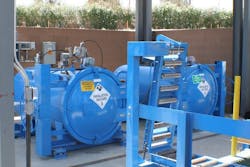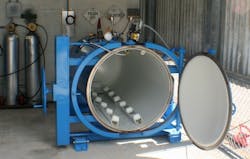Vessel Safety
About the author:
Cliff Lebowitz is principal and editorial director for Catalytic Reporting. Lebowitz can be reached at [email protected]
The chief operator for a 6-million-gal-per-day (mgd) surface water treatment plant reported enhanced safety regarding chlorine gas for disinfection after using special cylinder containment vessels because they contain leaks while preserving the opportunity to use leaked gas. In addition, change-out time for used cylinders to their backups has been cut by 50%.
“When it comes to chlorine gas, no release is a good release, and the less time you’re around it, the better off you are,” said Mike Holloway, chief operator for the Walnut Creek Special Utility District in Lake Bridgeport, Texas.
“We hadn’t been having any problems with leaks with the 150-lb bottles that we used for many years, but while we were looking at changing to one-ton cylinders to make our chlorine supply operation much easier, we were glad to see an ad in a magazine for the special containment vessels,” Holloway said. “We’ve been relieved of a lot of our concern about costs to health by adding those units to help keep everyone safe. It’s been great for me; I don’t have near as much concern about leaks.”
The 1-ton units, supplied with loaders, scale systems and instrumentation, were manufactured by TGO Technologies, also known by its product name of ChlorTainer, of Santa Rosa, Calif.
“When we first installed them in 2012, the manufacturer came down to train everyone in their use, and as staff has changed over the years, we’ve been able to easily train the new people ourselves,” Holloway said. “In addition to the safety enhancement, we’ve been able to cut cylinder change-out time to 10 minutes, from the 20 minutes it took us with the 150s.”
The 6-mgd plant’s average flow is approximately 3 mgd, with a range from about 1.8 to 2 mgd to 4.2 mgd. The plant consists of six package plants, 1 mgd each, that share a common clearwell. Two 1-ton chlorine gas cylinders are kept in separate containment vessels in a separate building, with three separate water supplies carrying the gas to three chlorimeters. Gas use ranges from 50 to 130 lb per day and averages 100 lb per day.
Chlorine is introduced as chlorine dioxide before the addition of alum and polymer coagulants. It then is introduced a second time as free chlorine—1.5 to 2 mg/L—after filtration and before the clearwell, and finally it is introduced at 3.4 mg/L, with 0.9 to
1.3 mg/L liquid ammonium sulfate (LAS), before entering ground storage.
Previously, Holloway said, beginning with the plant startup in 1995 as a 2-mgd facility, chlorine gas was supplied in 150-lb bottles, nine at a time. Then, the plant expanded to 4 mgd.
“It got to a point where there was lots of moving of cylinders, especially in the summer, and lots of them on site,” he said. “We were changing out cylinders frequently, especially during peak demand. By 2010, we started thinking about how we might contain any releases while changing to 1-ton cylinders, and discussed it with our consulting engineer, including how we might change our setup. Once we learned about the ChlorTainers, we didn’t see a need to look at any other type of containment.”
The ChlorTainer cylinder containment vessels are nitrogen-powered with a fail-safe actuator automatically shutting off the chlorine supply if power is lost. It remains shut down until it is safe to resume operation. The design allows for automatically resetting a seismic detection device that can be connected. The self-contained, simple, passive design means there are no pumps, fans, scrubbers or caustic circulation systems, nor is there any need for backup electric power.
The vessels enclose chlorine gas cylinders, the chlorine transfer hose and seismic lockdown brackets. The chlorine transfer hose is attached to the supply valve, pressurized and tested for any leaks at the hose ends. The door is closed and secured by a clamshell locking mechanism.
Operators switch to the standby containment vessel automatically when the full cylinder runs empty, opening the vacuum breaker valve. The switchover is performed automatically and does not require personnel to be present.
With any accidental leaks of chlorine kept within the containment vessel, no atmospheric venting is generated. The vessels are ASME-rated pressure tanks, and any leaks are recycled to the injection system at a normal flow rate. A fail-safe valve ties into the chlorine leak detection sensor so that in the event of an external release, the nitrogen failsafe valve will close, stopping it completely.
Any leak or release of chlorine gas from the vacuum line downstream of a vacuum regulator will lose the vacuum condition and cause the vacuum regulator to close, stopping the flow of chlorine gas to the vacuum line. The maximum release of chlorine gas will be the amount of chlorine gas that is the length of the vacuum line to the chlorine injector, and not drawn into the water solution by the suction of the injector.
The vessels’ life expectancy is stated as no less than 100 years, given proper maintenance, which includes changing out the Viton O-ring on the door. The annual maintenance on the vessels requires as little as less than five minutes and costs less than $200.
In a further commitment to serving the water industry, ChlorTainer is partnering with the American Water Works Assn. (AWWA) to financially support aspiring civil and environmental engineers and encourage their entry into that industry. For every ChlorTainer unit sold, the company will donate $1,000 toward engineering scholarships. The donation will go to the corresponding AWWA Section scholarship fund for the municipality that purchases the unit(s). Further information is available via the AWWA scholarship page.

